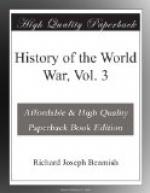be established. Shortly thereafter a German
reconnoitring group, which was parrying the destroyer
attack, received an attack from the northeast.
The cruiser Wiesbaden was soon put out of action
in this attack. The German torpedo flotillas
immediately attacked the heavy ships.
Appearing shadow-like from the haze bank to the northeast was made out a long line of at least twenty-five battleships, which at first sought a junction with the British battle cruisers and those of the Queen Elizabeth type on a northwesterly to westerly course, and then turned on an easterly to southeasterly course.
With the advent of the British main fleet, whose centre consisted of three squadrons of eight battleships each, with a fast division of three battle cruisers of the Invincible type on the northern-end, and three of the newest vessels of the Royal Sovereign class, armed with fifteen-inch guns, at the southern end, there began about 8 o’clock in the evening the third section of the engagement, embracing the combat between the main fleets.
Vice Admiral Seheer determined to attack the British main fleet, which he now recognised was completely assembled and about doubly superior. The German battleship squadron, headed by battle cruisers, steered first toward the extensive haze bank to the northeast, where the crippled cruiser Wiesbaden was still receiving a heavy fire. Around the Wiesbaden stubborn individual fights under quickly changing conditions now occurred.
The light enemy forces, supported by an armored cruiser squadron of five ships of the Minatour, Achilles, and Duke of Edinburgh classes coming from the northeast, were encountered and apparently surprised on account of the decreasing visibility of our battle cruisers and leading battleship division. The squadron came under a violent and heavy fire by which the small cruisers Defense and Black Prince were sunk. The cruiser Warrior regained its own line a wreck and later sank. Another small cruiser was damaged severely.
Two destroyers already had fallen victims to the attack of German torpedo boats against the leading British battleships and a small cruiser and two destroyers were damaged. The German battle cruisers and leading battleship division had in these engagements come under increased fire of the enemy’s battleship squadron, which, shortly after 8 o’clock, could be made out in the haze turning to the north-eastward and finally to the east, Germans observed, amid the artillery combat and shelling of great intensity, signs of the effect of good shooting between 8.20 and 8.30 o’clock particularly. Several officers on German ships observed that a battleship of the Queen Elizabeth class blew up under conditions similar to that of the Queen Mary. The Invincible sank after being hit severely. A ship of the Iron Duke class had earlier received a torpedo hit, and one of the Queen Elizabeth class was




